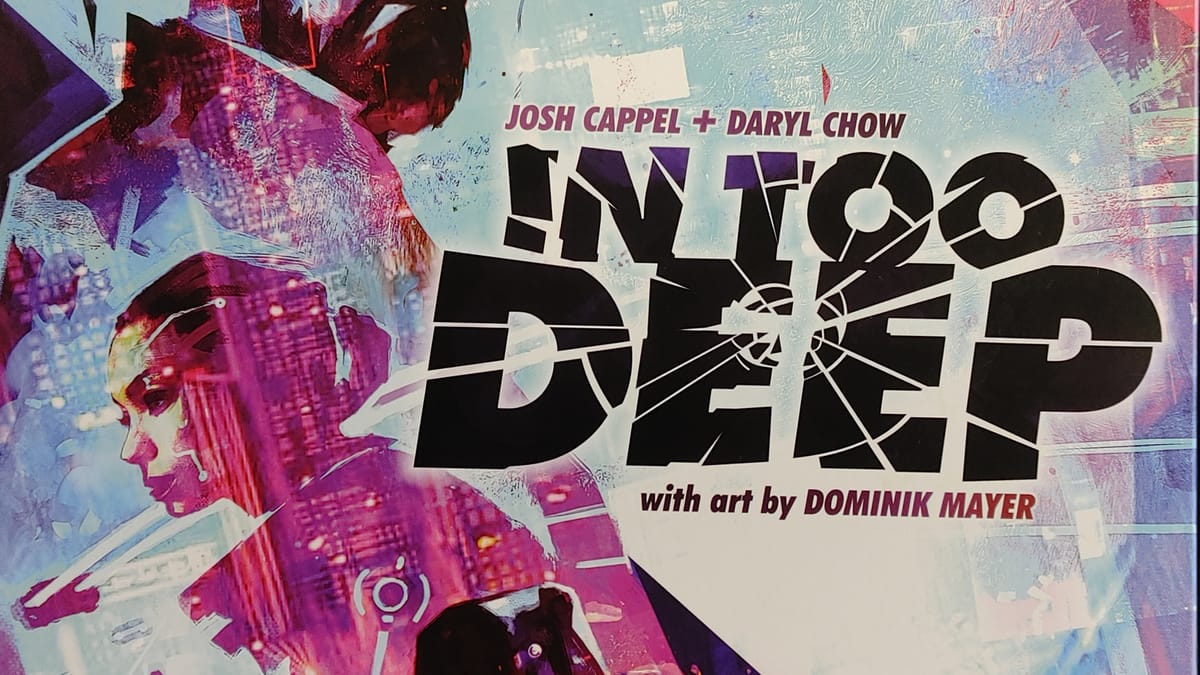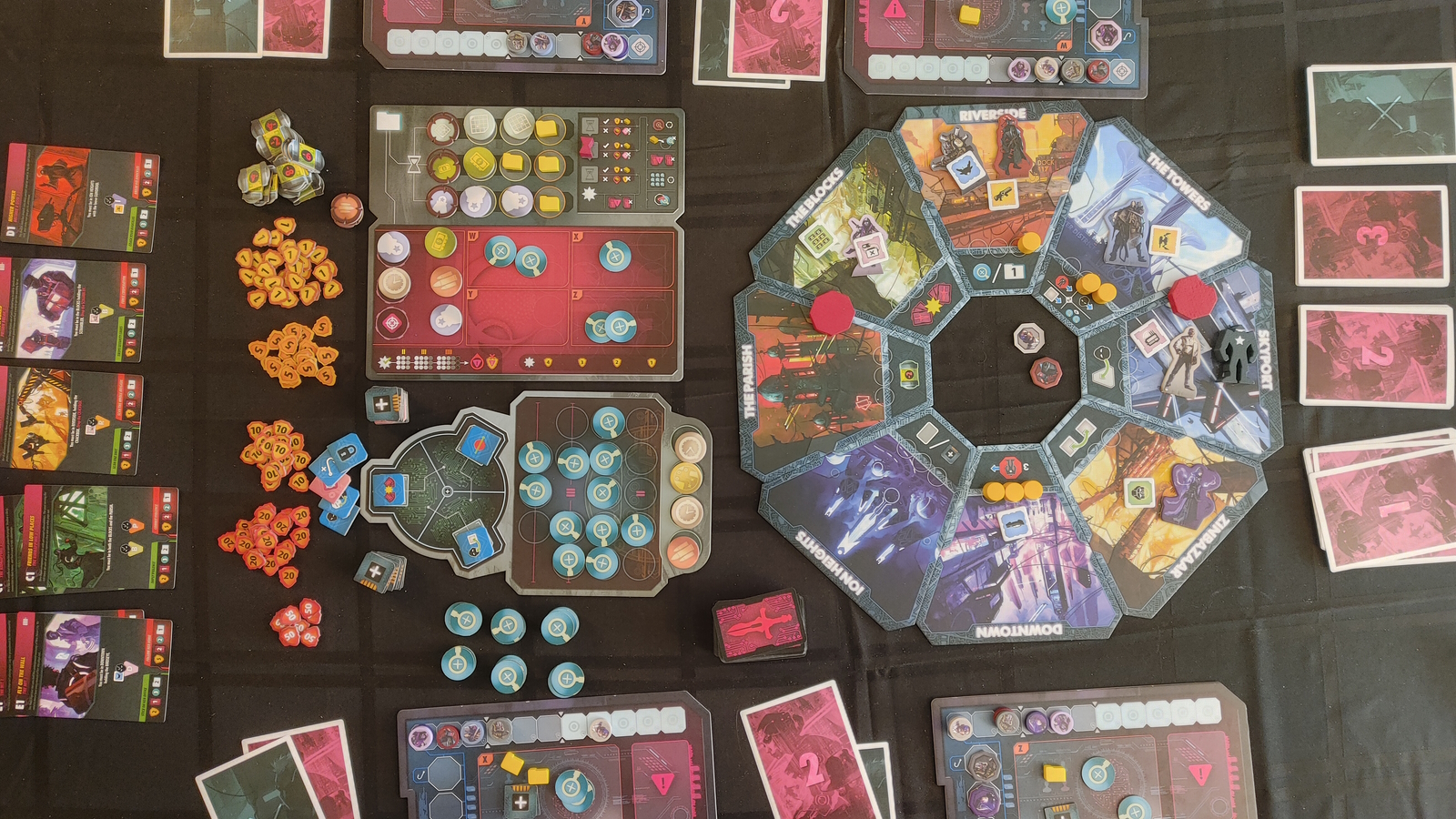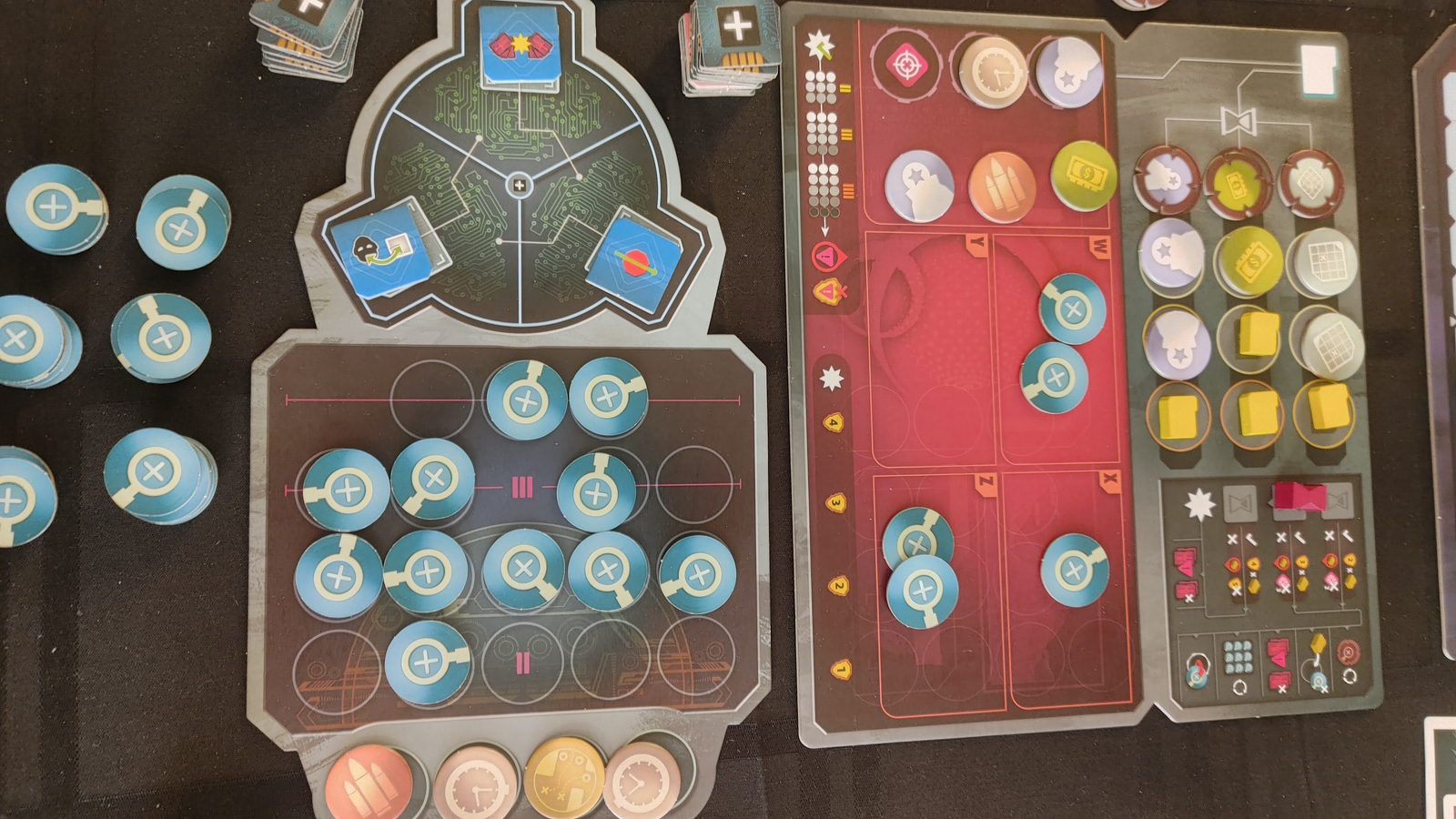
New Dawn City is under attack. The insidious Syndicate has set its sights on the last bastion of order in the not-so-distant future, and has sent its cyborg minions to take over your fair city. It’s up to you, a team of hackers utilizing an experimental system, to hack into the brains of the Syndicate’s agents and use them to expose their leaders. Of course, that means being the bad guy, committing crimes, and in turn, corrupting your own soul. Will the Syndicate be stopped? And will you go in too deep?
In Too Deep is a cyberpunk themed board game for 2-5 players. Players will be competing with each other to control criminals, use those criminals to commit crimes, and file evidence of the Syndicate’s plans uncovered by those crimes. This evidence is used to foil the Syndicate’s plan, as well as providing the lion’s share of the points in end game scoring.
Each player starts their turn by hooking into a criminal, if they desire, and then taking 2 actions with any criminals they control. Criminals have several options, such as moving around the city, picking up items, using the action of the region the criminal is in, or a special action unique to each criminal. That special action only unlocks if a player has a certain amount of grip, a resource representing the comfort and skill with which you control a criminal, gained each turn the player is hooked in.

The goal is to accomplish one of the two crime cards the player is holding. One of these cards, Side Crimes, can be spent as a free action, and can modify the situation in the city in numerous ways, such as moving a criminal, moving the robo-cop like enforcer, or exchanging items. The other are story cards that come in 3 chapters of increasing difficulty, which are major scoring cards and are part of the overall criminal plot. Either side crime or story crime, they both require a very specific setup on the card to be set up on the board before being turned in. This could mean having a criminal holding the cash with a getaway vehicle, or standing on the opposite region from the enforcer with a weapon to take it out, or any number of other situations.
There are 3 scoring rounds, where players working towards stopping the Syndicate are rewarded, while those who aren’t working hard enough are punished. These rounds trigger once all of the evidence is used up, which can happen quite quickly with each player completing one or two crimes a turn.

Once all three scoring rounds go by, an end game scoring round occurs. The player with the most corruption gets a boatload of negative points IF the syndicate is stopped, and the player with the least gets a boat load of positive points. Whether the Syndicate is stopped is dependent on the evidence filed, which also determines the points each evidence is worth. Since evidence filed doesn’t earn points, but does change what each token is worth, it behooves players to hold onto evidence they learn has been filed more than others, and to use actions to gain that information whenever possible.
This only really covers the barest parts of this game. There’s a lot to In Too Deep, and I love the minutiae of, say, using the Robocop Enforcer to move a criminal holding an item you need to a criminal you control, so that criminal can then steal it and use it to complete a crime card. But that same minutiae means there is a TON of keep track of, and the crime cards are specific enough that it’s hard to make long term plans. A single item moving out of position could mean that you throw away a crime card to look for something easier. This also means that every player is looking at the board fresh when their turn comes around. Turns can take ages, especially if you’re playing with someone who already has a hard time with analysis paralysis. On the other hand, it is very satisfying completing a difficult, but oh-so-rewarding chapter 3 crime card. It takes a lot of maneuvering and resources, but rewards a ton of information and points near the end of the game. Planning well is rewarded well, but planning takes time, and that means the game can drag on.

Because of the time each turn can take, I would never, ever, recommend playing this game with 5 players. It pushes the time between turns to the brink of reason. Some groups of players can probably handle it just fine, if everyone takes a breezy, quick (if sub-optimal) turn. But in mixed company, or with new players, it’s gonna be a long game. 4 players might be the sweet spot. You get access to a large caste of criminals to play with, the rounds are tense with “are you gonna screw me up” energy, but there is still a pretty good chance that things will line up so that you can make plans a turn or two in advance.
I also want to point out the absolutely gorgeous art and design of this game. Each of the pieces are satisfying to play with, and the box is chock full of them. Each sector of the city, which can be configured differently each game, is a beautiful diorama with a hint of color-coding. Each criminal is distinct, cool, and dangerous looking in their own way. These are people you do NOT want to meet in a dark alley. Even the wooden pieces, like the big red blockades, yellow heat markers and chunky dossiers, give you warm fuzzies to move around.

This has been the hardest game for me to pin down in my time reviewing board games. I’ve had an amazing time playing it, but it’s hard to really give an elevator pitch for it. I think the best I’ve come up with is “Blade Runner” meets “Point Break”. On one hand, the tense gameplay, planning and payoff definitely lends to a recommendation from me. On the other hand, there’s a lot of complexity to In Too Deep. It is the worst experience I’ve ever had trying to teach a board game.
It’s not a game for everyone, but for the right kind of person, the theme, the mechanics, and the terrifying depths of what’s possible are going to be exactly what they are looking for.
In Too Deep
Great
An extremely unique, full featured puzzler with hidden scoring. Extremely captivating art and theme are brought down by difficult setup, teach, and long run time. If you don’t mind having your mind scrambled for a few hours, it’s a good time.
Pros
- Unique scoring and gameplay
- Beautiful artwork across the entire game
- Deep puzzle mechanics
Cons
- Analysis Paralysis: The Game
- A real chore to set up and teach
- Marked for up to 5 players. Don't do it. 3-4 only.
